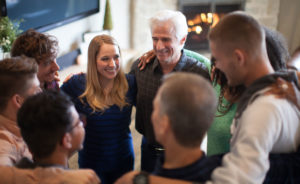Starting a Special Needs Ministry for Children in Your Church: Planning for it and Training Your People
Four summers ago, while working at my church as the Director of Special Needs, I met a six-year-old boy named Judah. My first encounter with Judah started with a frantic call from our elementary classroom stating that he had escaped. He had become overstimulated by all the toys, music, and yelling that is common in a children’s classroom and ran out into the hall because he didn’t know how to handle it.
While I can definitely relate to wanting to run out of kid’s classrooms at times, Judah’s particular situation was different. He dealt with Sensory Processing Disorder and select developmental delays, which is a complex way of saying that he was still working on his communication skills and had a hard time with things that overwhelmed his five senses.
One pair of headphones and a few fidget toys later, I found Judah to be one of the most happy, good-natured children I have met to this day. We just had to learn how to help him succeed.
Starting a ministry for children with special needs can seem intimidating, but having a solid plan and training at the beginning can set you miles ahead and give you a strong foundation on which to grow your program.
5 Tips for Planning Your Ministry
Assess your current needs.
Take an account of the children with special needs already within your kids ministry to determine how many volunteers you will need to start your ministry. A one-to-one ratio is ideal for ensuring the children’s care and safety.
Lay out your volunteer qualification guidelines.
Lay out your church’s guidelines of what kind of volunteer would be a good fit for this type of ministry. Obviously, not everyone can be a college graduate with a degree in special needs, but it is wise to establish some ground qualifications. Something to keep in mind is that these kids can sometimes do unexpected things, and having someone who can remain calm and can use discernment when being thrown a curve ball can be very beneficial. That is why I typically recommend looking for volunteers that are over 18 and, if possible, have children of their own or some prior experience with children.
Create your intake process.
Having a clearly thought-through intake process not only helps you build a relationship with the family you are serving, but also gives them the confidence that you are professional and thorough. Very simple steps such as an intake form and possibly a scheduled meeting time with the child’s parents can enable you to learn vital information about the child as well as help the parents feel more comfortable leaving them with you.
Set your policies and safety procedures.
Children with special needs definitely come with some different situations. Because of this, having some general guidelines for operation can help you know that the kids in your care are in a safe environment during their time at church. It would be unreasonable to try and write every case that could possibly come up, but having some broad statements in place can help guide your volunteers in the right direction when making a decision. Below is a list of some common topics you may encounter that would be beneficial to have a policy for based on your church’s facilities:
- Transferring kids from their wheelchairs
- Diaper changing for older children
- Restraining
- Drinks/snacks
- Rescue meds
- Contacting EMSA
Find a curriculum.
Many times programs for special needs children can turn into basic baby-sitting, but it is immensely important that these kids are given the same opportunities as the other children to hear about God and his love for us. Whether you decide to buy a curriculum or adapt the lessons from your other kid’s classrooms, know that all children with special needs are very different and modifications may need to be made to bring the lesson to their cognitive level. Some kids will be able to read and write, while others may just like to be sung and read to. Some kids need to be moving to learn, and some kids need to be sitting still. You’re probably not likely to figure out what they need on the first try, but the important thing is that you don’t give up trying until you find a lesson method that works for them.
6 Training Points for Your Volunteers
Once you have your planning done, the next step is to equip your volunteers with the necessary training to help them feel comfortable within the classroom.
All kids are different.
Never assume that one child with a disability operates the same as another child with that same disability. You may have heard the phrase, “Meeting one child with autism only means you have met ONE child with autism.” That statement couldn’t be more accurate. These children all have different strengths, likes, dislikes, and triggers. Take time to learn about that individual child before assuming you know how to work with them.
Learn from the parents/guardians.
No one knows these children as well as the people with which they live. Encourage your volunteers to take time to build a relationship with the parents and to keep very open communication. After every service, have them talk with the parents about wins, the child’s lesson that day, and struggles if needed.
Do some research.
Motivate your volunteers to do some light research on the disability of the child with which they are working. This can equip them with the knowledge they need to create solutions for working with that particular child.
Provide tools, not toys.
When a child is exhibiting negative behaviors, it is very tempting to hand them a basket of toys and let them sit in the back of the room. This is why it’s important to coach your volunteers in how to use the materials in the room as tools instead of toys. The goal is to help them succeed in learning the lesson, not to distract them from the lesson. For example, you could tell a child that they can keep ONE small toy with them as long as they stay in their seat, but if they get up we have to put the toy away. That is taking a regular toy in the room and using it to encourage a good behavior.
Be proactive, not reactive.
This simply means that it is better to try and stop an undesired behavior from happening, than to continually be correcting a child for the same behavior over and over again. Encourage your volunteers to try and watch for what could be causing the behavior so that they can come up with proactive solutions to replace the behavior with a better alternative. For example, if you have a child that continuously runs around the room towards the end of the lesson, you could probably conclude that that child’s attention span runs out after a certain amount of time. Rather than just waiting for it to happen and chasing the child around, look for signs of those behaviors beginning (such as wiggling in their chair) and tell them they can take a quick break to do jumping jacks in the back of the room before they return to their chair.
Stay flexible.
I think it goes without saying that sometimes things don’t go as planned with kids in general. Some weekends are going to go better than others, and it is crucial that you continue to remind your volunteers not to get discouraged when everything doesn’t go smoothly. Just encourage them to continue looking for the wins and brainstorming new ideas until they find something that works for that child.
For a quick resource on the thirteen categories of disability classified under IDEA, click here, and, as always, feel free to chat with us if you have any questions!
Train church volunteers and disciples online, easy.
Use our simple on-demand video training courses to equip volunteers, develop leaders, and teach disciples. Create your own training or use our video library. Our training automation platform makes it simple and fast to get your people ready for ministry.
Other Posts You May Like
All Growth Begins with Self-Awareness
My first year on the YouVersion Bible App team was exciting and challenging. I joined the team to help with partnerships and community-building. Like any new job, the first year came with a learning curve and the need to pick up new skills. I had never been part of a technology team before, so I…
Is Your Leadership Style Helping or Hurting You?
Your leadership style — how you make decisions, connect with and influence others, delegate, handle conflict, cast vision — is shaped by many factors. Your family history and work experience, along with your personality and internal wiring, impact how you think about and “do” leadership today. Leaders we have worked with, for better or worse,…
A Church Is Only As Healthy As Its Team
When you joined the team at your church, what kind of training did you get in the first weeks? Did you have an HR meeting to cover the health insurance and retirement accounts? Did you cover how to submit an expense report or reserve a room on the master calendar? How about how to handle…



